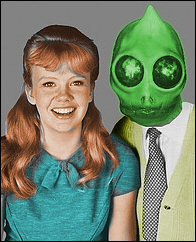Fingerprints, while still valuable as a forensic tool in law enforcement, are not the be-all and end-all of crime solving like they used to be. Not that you would know it from police procedure television shows. Typically prints are used to verify identity when all other methods fail or can not be trusted.
They also provide another bit of evidence that can be used to determine if someone was present in a certain location or used a certain object. However, since they can be scanned and printed onto a variety of materials they can sometimes fail as a biometric or forensic tool. Bad guys could, technology allowing, conceivably wear prosthesis with false or misleading prints, though they are probably for the time being beyond the means of the common criminal.
Creating fingerprints that would defeat false-print detection technology probably yet requires some sophistication in their making. I speculate they have already been put into place during certain ops or by high-end criminal enterprises. Anyone needing a fall guy need only to plant a print and some DNA and that person goes to jail for ever or their life is utterly destroyed. It could also be used to provide evidence where there is none. A verified chain of custody would remove any number of conspirators that might flip or tattle by allowing them true discovery of prints and even DNA, if biological material was used in conjunction with the prosthesis.
I have no idea if the reproduced thumbprint on the instructions tab of the car windshield sun screen are the fingerprint-featured man from an old human resources advertisement are actual prints from a real person. They could be works of art made by pen and ink. Genuine or created the source could be decades old and is considered free-use by any and all. A simple internet search reveals many examples of real fingerprints available for adapting to finger covers. The ease in finding actual prints by even the most casual browser leads me to wonder if their exist databases of fake fingerprints that may be commonly found by investigative agencies from time to time, similar in the way there exist databases of phone numbers used in popular media, mainly those starting with the prefix 555. .
Certain phone numbers are rarely issued to the public because they owners would be subjected to nuisance calls day and night. For instance a phone number that shouldn't be active, yet is, is the famous 867-5309 from the Tommy Tutone song. Anyone claiming that number as their real phone number would have to provide proof it is actually theirs. The number would certainly cause an alert somewhere if someone tries to use it in any official capacity, such as when providing a contact number to police. The popularity of the number is such that it can be used at nearly any point of sale pad as an alternate type of customer loyalty card in just about any store by entering their area code and the number.
Odds are the number will work just fine as someone somewhere thought they were being clever and uses an easily-remembered number to gain their product discounts. Some companies have locked 867-5309 out of their systems as it skews consumer purchase data or allows access to substantial discounts based on accumulated sales volume and tracking. One wonders if false fingerprints that shouldn't belong to a living person are in a system somewhere and could create a similar red flag.
A few years ago making fake prints was nearly impossible, was highly technical and expensive. It primarily existed as an unlikely plot element in conspiracy stories of film and literature. Today the creation of a false print can be accomplished by the kitchen chem-lab amateur that would be of good enough quality to trick low-end security systems. Imagine how easy planting a fake one at a crime scene would be for investigators to discover.
But where the phone numbers are maintained by the telecom companies are fake or notorious fingerprints monitored by governments? Would a planted fingerprint collected as evidence derived from a deceased terrorist create an alert when scanned into a system? Names do, certainly. Some people have derided security agencies for keeping the 9/11 hijacker names and other notorious or non-active terrorists on no-fly lists. The question is, why bother? They are either dead or it is unlikely they would take a plane ride. The simple reason is that new villains may use the names of martyrs to make some kind of point in their terrible goal. It is not inconceivable that someone would plant a print as a secret message.
So is there some secret database somewhere that maintains a record of fingerprints that are privately and publicly available but unlikely to be found in real situations? If it does exist does it serve to provide source material for black ops? Is it used to check unlikely prints belonging to the famous, infamous or villainous? Has the data been used to prosecute the innocent? Direct suspicion away from the true perpetrator? Convict someone who got away clean that everyone knew was guilty but could not prove it? Subvert security systems? I can not really conceive that there is not such a category among fingerprint databases that covert agencies pay attention to. It would be remarkably careless not to have such records, just to rule out the crazy, dangerous or creative.
I don't think we'll be through the looking glass anytime soon, people.


























I think I used to call that number 876-5309 when I was a kid. I'm sure I wasn't the only one. Those poor people whoever they were-- I feel bad for them.
ReplyDeleteI've read accounts where they number caused a huge amount of grief for the original owners. Now the number is sold for a high price to those who want it.
ReplyDelete